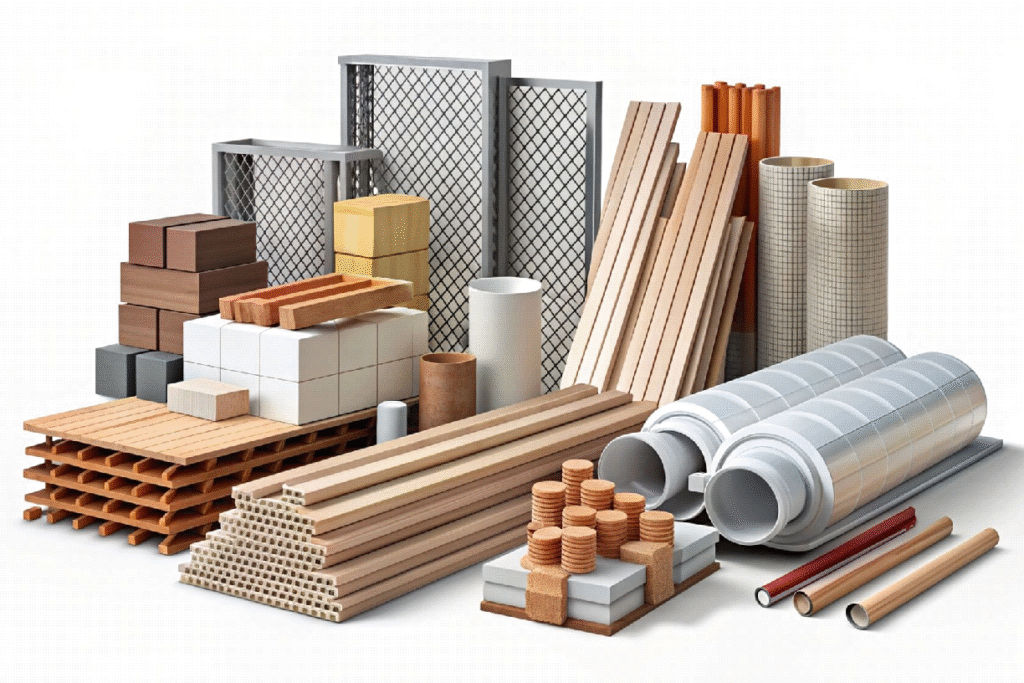Introduction
When you think about constructing a building—whether it’s a cozy home or a massive skyscraper—building materials form the backbone of the entire structure. They determine the project’s strength, safety, and sustainability. Simply put, great buildings start with great materials.
Understanding Building Materials
Building materials are the substances used to construct structures, from homes and offices to bridges and roads. They can be natural, like stone and wood, or synthetic, like concrete and steel. The right combination ensures stability, functionality, and beauty.
Types of Building Materials
Structural Materials
These provide the main strength of the structure—like steel beams, cement, and concrete.
Finishing Materials
Used for the final look and feel of the structure, including tiles, paints, and plaster.
Insulating Materials
Used to control temperature, noise, and moisture, such as foam boards, glass wool, and cork.
Common Building Materials and Their Uses
Cement and Concrete
The foundation of modern construction. Cement acts as a binder, while concrete—a mix of cement, sand, and aggregates—is known for its durability and compressive strength.
Steel and Metals
Used in frameworks, reinforcements, and roofing. Steel offers unmatched strength and flexibility, essential for skyscrapers and bridges.
Wood and Timber
Loved for its natural beauty and insulation properties, wood is used in flooring, roofing, and interior design.
Bricks and Blocks
Timeless and reliable, bricks provide strong, fire-resistant walls, while concrete blocks are ideal for quick and large-scale projects.
Glass
Modern architecture thrives on glass—used for windows, facades, and skylights, offering elegance and energy efficiency.
Plastics and Polymers
Lightweight, weather-resistant, and versatile—these materials are increasingly popular for plumbing, insulation, and decorative finishes.
Modern Construction Materials
Smart Materials
Materials that adapt to environmental changes, such as temperature-sensitive glass or self-healing concrete.
Green and Sustainable Options
Eco-conscious builders now opt for recycled, renewable, and low-carbon materials to reduce environmental impact.
Composite Materials
These blend two or more materials for improved performance—like fiber-reinforced concrete or metal composites.
Eco-Friendly Building Materials
Sustainability is shaping the future of construction. Here are some eco-friendly alternatives:
- Bamboo: Strong, renewable, and perfect for frameworks and flooring.
- Recycled Steel: Reduces waste and saves natural resources.
- Rammed Earth and Hempcrete: Natural materials that provide insulation and durability.
- Solar Tiles and Insulation: Turn your building into an energy-efficient powerhouse.
Factors to Consider When Choosing Building Materials
- Durability: Can the material withstand time and weather conditions?
- Cost: Is it affordable without sacrificing quality?
- Environmental Impact: Does it promote sustainability?
- Aesthetic Appeal: Does it match the project’s design vision?
- Maintenance: Is it easy to clean, repair, or replace?
Building Materials for Residential Projects
For homes, materials like bricks, wood, and concrete are the go-to choices. Roofing often uses asphalt shingles or clay tiles, while ceramic or vinyl flooring adds durability and style. The goal is to balance comfort, beauty, and cost-efficiency.
Building Materials for Commercial Projects
Commercial buildings rely on steel, reinforced concrete, and glass for strength, safety, and aesthetics. Fire-resistant materials and sound insulation are also key to ensure long-term safety and comfort.
Innovations in Building Materials
3D Printed Concrete
Imagine printing an entire house! 3D printing technology allows for rapid, cost-effective, and sustainable construction.
Self-Healing Materials
These materials repair cracks automatically, reducing maintenance costs.
Nanotechnology
Nano-coatings enhance surface protection, making materials more resistant to water, dirt, and corrosion.
The Role of Technology in Material Production
With automation and AI, material production is now faster and more precise. Digital sensors ensure consistent quality, and tracking systems monitor supply chains for efficiency.
The Economic Impact of Building Materials
Building materials play a major role in the global economy. Price fluctuations in cement, steel, or timber can affect construction costs worldwide. Local sourcing and recycling help stabilize costs and support local industries.
Sustainable Construction Practices
To protect our planet, builders are adopting eco-friendly practices like:
- Using locally sourced materials
- Recycling old construction waste
- Choosing low-carbon products
- Opting for modular construction methods
Future Trends in Building Materials
The future is smart and green. Expect to see:
- AI-based material selection tools
- Energy-efficient insulation
- Carbon-negative concrete
- Bio-based materials that grow instead of being mined
Conclusion
Building materials are the heart of construction—they shape how we live, work, and interact with our environment. As innovation meets sustainability, we’re entering an exciting era where structures are not just stronger but also smarter and greener. Whether you’re constructing a new home or a commercial complex, choosing the right materials will define the project’s success for decades to come.
FAQs
- What are the most commonly used building materials?
Concrete, steel, wood, and bricks are the most widely used materials in modern construction. - Which building material is best for eco-friendly homes?
Bamboo, recycled steel, and hempcrete are excellent sustainable choices. - How do I choose the right materials for my project?
Consider your budget, design goals, and the local climate before choosing materials. - Are modern materials more expensive than traditional ones?
Not necessarily—many modern materials offer long-term savings due to durability and energy efficiency. - What trends are shaping the future of building materials?
Smart, self-healing, and carbon-neutral materials are leading the future of construction.
READ ALSO: Top 10 Most Recommended AI Face Swap Applications to Use in 2025



